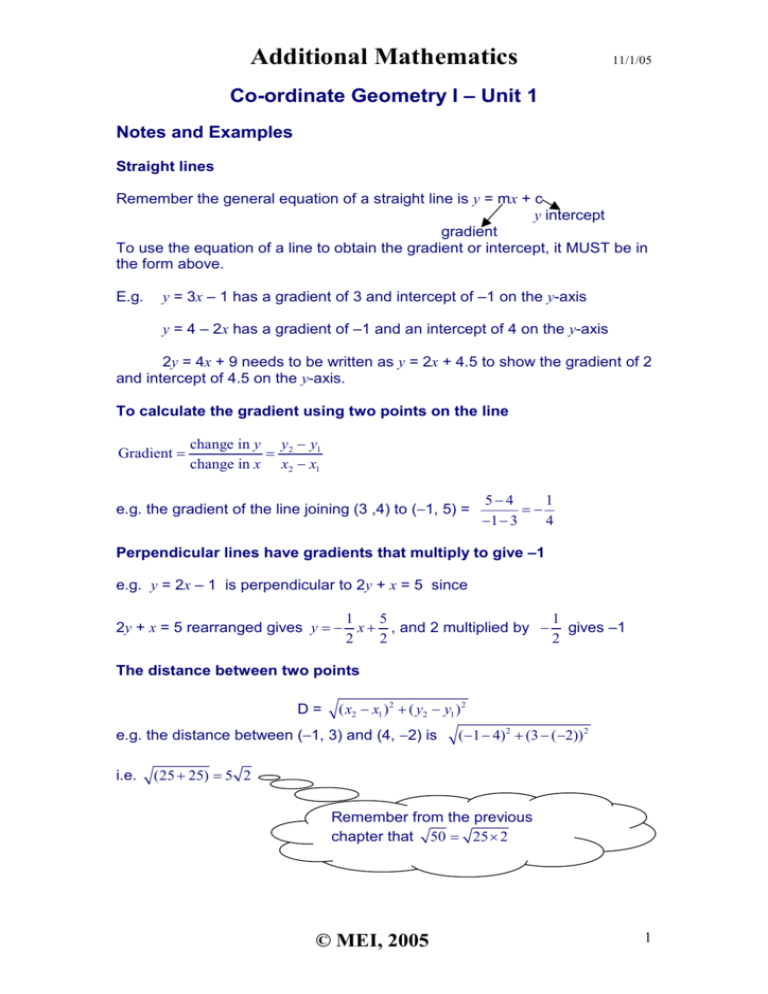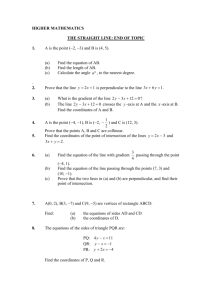Coordinate Geometry (Parts 1,2,3 and Assessment)
advertisement

Additional Mathematics 11/1/05 Co-ordinate Geometry I – Unit 1 Notes and Examples Straight lines Remember the general equation of a straight line is y = mx + c y intercept gradient To use the equation of a line to obtain the gradient or intercept, it MUST be in the form above. E.g. y = 3x – 1 has a gradient of 3 and intercept of –1 on the y-axis y = 4 – 2x has a gradient of –1 and an intercept of 4 on the y-axis 2y = 4x + 9 needs to be written as y = 2x + 4.5 to show the gradient of 2 and intercept of 4.5 on the y-axis. To calculate the gradient using two points on the line Gradient = change in y y2 − y1 = change in x x2 − x1 e.g. the gradient of the line joining (3 ,4) to (-1, 5) = 5−4 1 =− −1 − 3 4 Perpendicular lines have gradients that multiply to give –1 e.g. y = 2x – 1 is perpendicular to 2y + x = 5 since 1 5 1 2y + x = 5 rearranged gives y = − x + , and 2 multiplied by − gives –1 2 2 2 The distance between two points D= ( x2 − x1 )2 + ( y2 − y1 ) 2 e.g. the distance between (-1, 3) and (4, -2) is i.e. (−1 − 4) 2 + (3 − (−2))2 (25 + 25) = 5 2 Remember from the previous chapter that 50 = 25 × 2 © MEI, 2005 1 Additional Mathematics 11/1/05 Midpoint of a line joining two points (a, b) and (h, k) a + h b + k M= , 2 2 e.g. the mid point of the line joining (3, -2) and (5, 4) is; 3 + 5 −2 + 4 2 , 2 i.e. the point (4, 1) Example 1 The co-ordinates of points A, B and C are (4, -3), (-1, 2) and (2, p) respectively. Find a value for p such that; a) ABC is a straight line b) ∠ ABC is a right angle. Solution a) ABC to be a straight line implies that the gradients of AB and BC are the same Gradient of AB = 1 p−2 Gradient of BC = 3 p−2 =1⇒p=5 3 b) ∠ ABC is a right angle implies that grad of AB × grad of BC = -1 p−2 × 1 = -1 ⇒ p = - 1 3 © MEI, 2005 2 Additional Mathematics 11/1/05 Co-ordinate Geometry I – unit 2 Notes and Examples Straight lines Equation of a line given the gradient and one point y − y1 = m( x − x1 ) e.g. the equation of the line with gradient 3 and passing through (2, 3) is y – 3 = 3 (x – 2) i.e. y = 3x – 3 Equation of a line given two points First you need to work out the gradient from the two points and then use the formula above. Alternatively you could use the formula that is developed in the textbook. e.g. Find the equation of the line that passes through (3, -1) and (4, -3) (−3 − (−1)) = −2 (4 − 3) The equation is given by y − (−1) = −2( x − 3) i.e. y + 2x = 5 Example 1 Gradient = Find the equations of the lines which are parallel and perpendicular to y = 2x – 3 and pass through the point (-1, 3) Solution y = 2x – 3 has gradient 2 Therefore the line parallel to this and passing through the given point is; y - 3 = 2 (x + 1) i.e. y = 2x + 5 The line perpendicular to the given line has gradient − 1 and the equation is; 2 1 y − 3 = − ( x + 1) 2 i.e. 2y + x = + 5 © MEI, 2005 1 Additional Mathematics 11/1/05 The intersection of two lines For this we need to use simultaneous equations Example 2 Find the point of intersection of 4x + 3y = 3 and x – y = 6 Solution 4x + 3y = 3 x–y=6 equation 1 equation 2 Multiply equation 2 by 3 to balance the coefficients of y 4x + 3y = 3 3x – 3y = 18 7x = 21 i.e. x = 3 Add the two equations to eliminate y 3–y=6 i.e. y = -3 Substitute into equation 2 The point of intersection of the given lines is (3, -3) © MEI, 2005 2 Additional Mathematics 11/1/05 Co-ordinate Geometry I – Unit 3 Notes and Examples The circle The general equation is x 2 + y 2 + 2 gx + 2 fy + c = 0 and this can be written as; ( x + g )2 + ( y + f ) 2 + c − g 2 − f 2 = 0 In this form the centre of the circle is given by (- g, - f) and the radius by ( g 2 + f 2 − c) Example 1 Find the centre and radius of the circle x2 + y2 + 4x – 6y –23 = 0 Solution x2 + y2 + 4x – 6y –23 = 0 (x2 + 4x) + (y2 – 6y) – 23 = 0 Using the technique of completing the square ((x + 2)2 – 4) + ((y – 3)2 – 9) – 23 = 0 (x + 2)2 + (y – 3)2 – 36 = 0 The centre is at (-2, 3) and the radius is 6 Example 2 Find the equation of the circle that passes through (2, 2) and has a centre at (4, 1) Solution The radius is given by the distance between the centre and (2, 2) r = (4 − 2)2 + (1 − 2)2 = 5 Equation of the circle is ( x − 4)2 + ( y − 1)2 = 5 © MEI, 2005 1 Additional Mathematics 11/1/05 Example 3 Show that the circle x2 + y2 – 6x – 4y + 9 = 0 touches the x axis and find the point at which this occurs. Solution If the circle cuts the x axis, then y = 0 at those points i.e. x2– 6x + 9 = 0 ⇒ (x – 3)2 = 0 i.e. only one point of intersection, therefore the circle touches the x axis at (3 , 0) © MEI, 2005 2 Additional Mathematics Chapter 5: Coordinate Geometry I Chapter Assessment 1 The points A and B have coordinates (2, 3) and (4, −1) respectively. Calculate (i) The gradient of the line AB, [1] (ii) The length of the line AB, [2] (iii) The coordinates of the mid-point of the line AB. 2 [2] The points A, B and C have coordinates (1, 2), (3, 5) and (6, −1) respectively. Find (i) The equation of the line through A parallel to BC, [3] (ii) The equation of the line through C parallel to AB, [3] (iii) The point, D, where these two lines intersect. 3 The points A, B, C and D have coordinates (0, 6), (5, 9), (6, 4) and (1, 1) respectively. (i) Find the coordinates of E, the point where the lines AC and BD intersect. [5] (ii) Show that AD and BC are parallel and equal in length. [4] (iii) Show that E bisects AC and DB. 4 [3] [2] The coordinates of the points A, B and C are (0, 4), (9, 7) and (8, 0) respectively. The points L, M, N are on the sides BC, CA and AB respectively of the triangle ABC such that AL is perpendicular to BC and BM is perpendicular to CA. The equation of the line AL is 7y + x = 28. (i) Find the gradient of the line AC and hence of the line BM. [2] (ii) Find the equation of the line BM. [2] (iii) Find the coordinates of the point P where AL and BM intersect. [3] (iv) Show that CP is perpendicular to the line AB. [3] © MEI, 18/04/05 1/2 Additional Mathematics 5 The vertices of a quadrilateral are A( −2, 12), B(5, 11), C(10, −4) and D(−3,5). (i) 6 Calculate the gradients of the diagonals AC and BD. Deduce a geometrical fact about these lines. [3] (ii) Find the equation of the line AC and show that E, the midpoint of BD, lies on it. [4] (i) Prove that the points A(-2, 1), B(2, 3) and C(8,6) lie on a straight line. [2] (ii) Find the equation of the line L perpendicular to ABC through C. [3] (iii) Given that O is the origin, find the equation of the line M parallel to OB through A. [3] (iv) Find the coordinates of the point D at which the lines L and M intersect. 7 [3] A circle has equation x2 + y2 − 8x − 10y + 16 = 0. (i) Show that the circle touches the x-axis and find the coordinates of the points where it cuts the y-axis. [4] (ii) Write down the radius and the coordinates of the centre of the circle. [3] Total: 60 © MEI, 18/04/05 2/2






